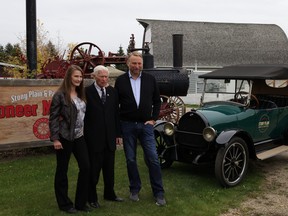 From left to right, Lisa, Gerry, and Gerard Levasseur present a fully-restored 1918 Willys-Overland touring car to the Stony Plain and Parkland Pioneer Museum on Sept. 30, 2021. Photo by Rudy Howell/Postmedia.
From left to right, Lisa, Gerry, and Gerard Levasseur present a fully-restored 1918 Willys-Overland touring car to the Stony Plain and Parkland Pioneer Museum on Sept. 30, 2021. Photo by Rudy Howell/Postmedia.
On Thursday, Sept. 30, Gerry Levasseur and his two children Gerard and Lisa, presented the museum with the donation of a fully-restored 1918 Willys-Overland touring car. In attendance were museum President Clifford Goerz and Vice President Roger Pederson among others.
“Items like this car are tangible pieces of history we touch and see operate. We can look to the future from seeing our past with excitement and appreciation,” said Gerard Levasseur.
Over the summer, the Levasseur family indicated to the museum it was looking to downsize its car collection. Without hesitation, staff members jumped at the opportunity to adopt the $46,000 touring car in particular. It was purchased by the Levasseurs in St. Louis, MO, but its routes can be traced back to Ohio. The 103-year-old vehicle was originally intended to be presented during last month’s Harvest Festival celebration but the museum decided to cancel the event due to the pandemic’s fourth wave.
The Willys-Overland model was of particular interest to the museum because it has long housed one in far worse condition, previously owned by famed Canadian aviator Wilfred “Wop” May (c. 1896–1952). It marks the 10th addition to the museum’s car and truck collection ranging in production years from 1913–1964.
“The car itself is a wonderful piece of history for us to have in our collection where we can protect it and keep it in the public view for years to come. Not only can we tell the story of (the car) on its own, but we can show what Wop May’s car would have looked like when it was new. It’s really kind of an extra bonus for us in telling these stories,” said Fielhaber.
For now, the new touring car will be stored indoors on the museum’s ‘Legacy Street.’ However, the plan is to one day display both May and Levasseur’s vehicles side-by-side when the museum has the proper space to do so.
“We have a deep appreciation for families like the Levasseurs who appreciate the history enough to want to not only preserve it themselves but help us preserve it. When you have that tie in the community it not only makes our job easier but creates a drive for people to work together,” said Fielhaber.